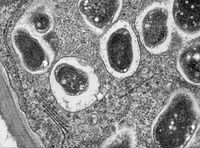
Synthesis, molecular docking simulation and enzymatic degradation of AB-type indole-based polyesters with improved thermal properties.
Sign Up to like & getrecommendations! Published in 2020 at "Biomacromolecules"
DOI: 10.1021/acs.biomac.9b01399
Abstract: We report the facile synthesis of a series of indole-based hydroxyl-carboxylate (AB-type) monomers by a one-step procedure. These monomers were successfully polymerized by melt-polycondensation to yield AB-type polyesters with a varied number of flexible methylene… read more here.
Keywords: degradation; based polyesters; type; molecular docking ... See more keywords

Hydrolysis of Ionic Phthalic Acid Based Polyesters by Wastewater Microorganisms and Their Enzymes.
Sign Up to like & getrecommendations! Published in 2017 at "Environmental science & technology"
DOI: 10.1021/acs.est.7b00062
Abstract: Water-soluble polyesters are used in a range of applications today and enter wastewater treatment plants after product utilization. However, little is known about extracellular enzymes and aquatic microorganisms involved in polyester biodegradation and mineralization. In… read more here.
Keywords: acid based; based polyesters; ionic phthalic; phthalic acid ... See more keywords

Bio-Based Polyesters with High Glass-Transition Temperaturesand Gas Barrier Properties Derived from Renewable Rigid TricyclicDiacid or Tetracyclic Anhydride
Sign Up to like & getrecommendations! Published in 2020 at "Macromolecules"
DOI: 10.1021/acs.macromol.0c00344
Abstract: Novel tricyclic diacid (TCDA) and tetracyclic anhydride (TCAH) were synthesized from renewable furan to generate a series of bio-based polyesters via melt polymerization (MP) of TCDA with seven lin... read more here.
Keywords: based polyesters; bio based; polyesters high; glass transition ... See more keywords

Recent Progress on Bio-Based Polyesters Derived from 2,5-Furandicarbonxylic Acid (FDCA)
Sign Up to like & getrecommendations! Published in 2022 at "Polymers"
DOI: 10.3390/polym14030625
Abstract: The big challenge today is the upgrading of sustainable materials to replace miscellaneous ones from petroleum resources. Thus, a generic bio-based building block lays the foundation of the huge bio-market to green economy. 2,5-Furandicarboxylic acid… read more here.
Keywords: acid fdca; based polyesters; bio based; bio ... See more keywords

Isosorbide and 2,5-Furandicarboxylic Acid Based (Co)Polyesters: Synthesis, Characterization, and Environmental Degradation
Sign Up to like & getrecommendations! Published in 2022 at "Polymers"
DOI: 10.3390/polym14183868
Abstract: Poly(2,5-furandicarboxylate)s incorporating aliphatic moieties represent a promising family of polyesters, typically entirely based on renewable resources and with tailored properties, notably degradability. This study aims to go beyond by developing poly(isosorbide 2,5-furandicarboxylate-co-dodecanedioate) copolyesters derived from… read more here.
Keywords: based polyesters; furandicarboxylic acid; isosorbide furandicarboxylic; acid based ... See more keywords